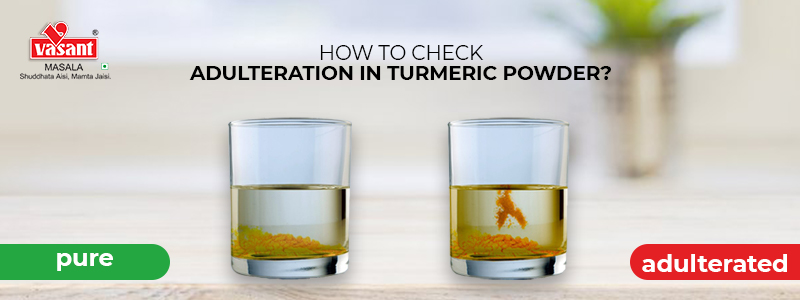
Indian cuisine is defined by the variety of spices incorporated in the recipes. The usage of distinctive spices is the secret ingredient that makes Indian cooking authentically Indian. Its unique flavour and scent have the power to dramatically change your dish. The quality of the spices we buy is becoming increasingly important these days. Adulteration is quite frequent, particularly in spices.
Most of us go to our local grocery stores to get our monthly supply of spices and condiments. Spices sold in bulk are more likely to be tainted. We may never know how simple it is to combine inferior materials with powdered condiments. Turmeric is one such significant spice that is adored not just for the wonderful colour and texture it provides to any cuisine but also for its therapeutic benefits. Turmeric powder is nowadays heavily adulterated, depriving it of all of its health benefits.
Widespread Turmeric Adulteration
Some individuals believe that adulteration of turmeric happens exclusively in powder form. They purchase the rhizome (the underground root) in the hope that it will alleviate their concerns about adulteration and ensure that they are purchasing genuine turmeric powder. The reality is that there are several species of turmeric, and it is critical to understand the Different Varieties of Turmeric. People may wind up getting inferior, worthless, or even wild turmeric if they do not know how to differentiate! Cunning marketers would frequently cover it with artificial colour to make it appear more appealing.
We at Vasant Masala procreate high-quality Natural Turmeric from Sangli, Maharashtra, which is processed in neatly maintained hygienic conditions. This turmeric is pure and rich in curcumin.
How is Turmeric Adulterated?
Turmeric is not only utilised as a flavouring ingredient but is also employed in Ayurvedic medicine to enhance immunity and serve as an anti-inflammatory. As a result, adulteration of turmeric powder poses a significant risk. Turmeric powder is commonly adulterated with:
- To increase the amount of turmeric powder, ingredients that have little nutritional value, such as daw dust, rice flour, chalk powder, or starch, are added.
- Along with the fillers, synthetic colour dyes, which includes chemicals like metanil yellow colour and lead chromate, are added to make turmeric powder seem brilliant and yellow.
For obvious reasons of storage and use, more individuals buy turmeric powder than any other form. Unfortunately, turmeric powder is the most easily tainted.
That raises an important question:
How To Check for Turmeric Powder Adulteration at Home?
- Palm Test
- Water Test
- Metanil Test
- Lead Chromate Test
- Chalk Powder Test
- Starch Test
Given its regular usage and the importance of turmeric to our health, it is critical that you choose the highest quality turmeric available. It may be difficult to tell the difference between real and fake turmeric just by looking at it. If you're not sure, do these turmeric adulteration tests to see if the turmeric you're currently using is impure and polished with adulterants.
Palm Test: Put a pinch of turmeric powder on your palm and massage it with the thumb of your other hand for 15-20 seconds. Pure turmeric powder will adhere to your palm, creating a strong yellow stain.
Much of the turmeric powder will adhere to your palm if you turn it upside down. However, if a large amount of turmeric powder falls, it indicates that it has been adulterated.
Water Test: You may perform this turmeric adulteration test at home. Take a glass flask of warm water and add a teaspoon of turmeric powder to it; let it sit for around 10-15 minutes.
If the turmeric powder settles down, it is real; if it does not settle down and leaves a dark yellow colour, it is adulterated.
Metanil Test: To test for the presence of metanil yellow, place a pinch of turmeric powder in a test tube, add a few drops of strong hydrochloric acid, and violently shake it.
If the solution becomes pink, this indicates the existence of metanil. Consuming turmeric powder that is high in metanil will make you feel nauseated, create stomach problems, and cause food poisoning.
Lead Chromate Test: To test the presence of lead chromate in turmeric powder, mix a teaspoon of turmeric powder with water. It will instantly leach streaks of water-soluble colour into the solution, indicating the presence of lead chromate.
Chalk Powder Test: To test for the presence of chalk powder in turmeric powder, place a teaspoon of turmeric powder in a test tube and fill it with few drops of water and hydrochloric acid.
The presence of chalk powder is indicated by the formation of bubbles in the solution. It might induce indigestion if consumed in excess.
Starch Test: Place the turmeric powder under a microscope to check for the presence of starch.
Turmeric particles are yellow, angular, and larger, whereas starch particles are light, white, spherical, and smaller.
Don't be fooled the next time you go grocery shopping. Make sure you get your condiments from well-known and trusted suppliers or brands, like Vasant Masala, and always double-check their authenticity.

